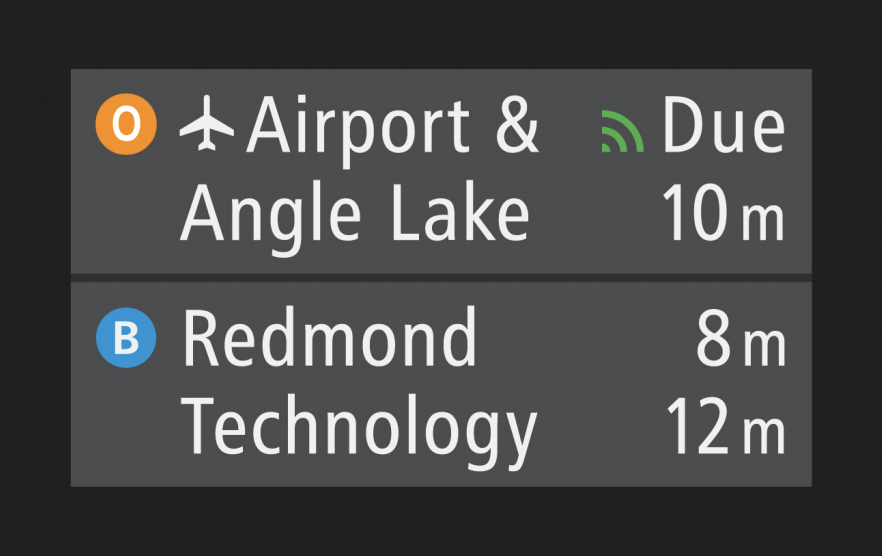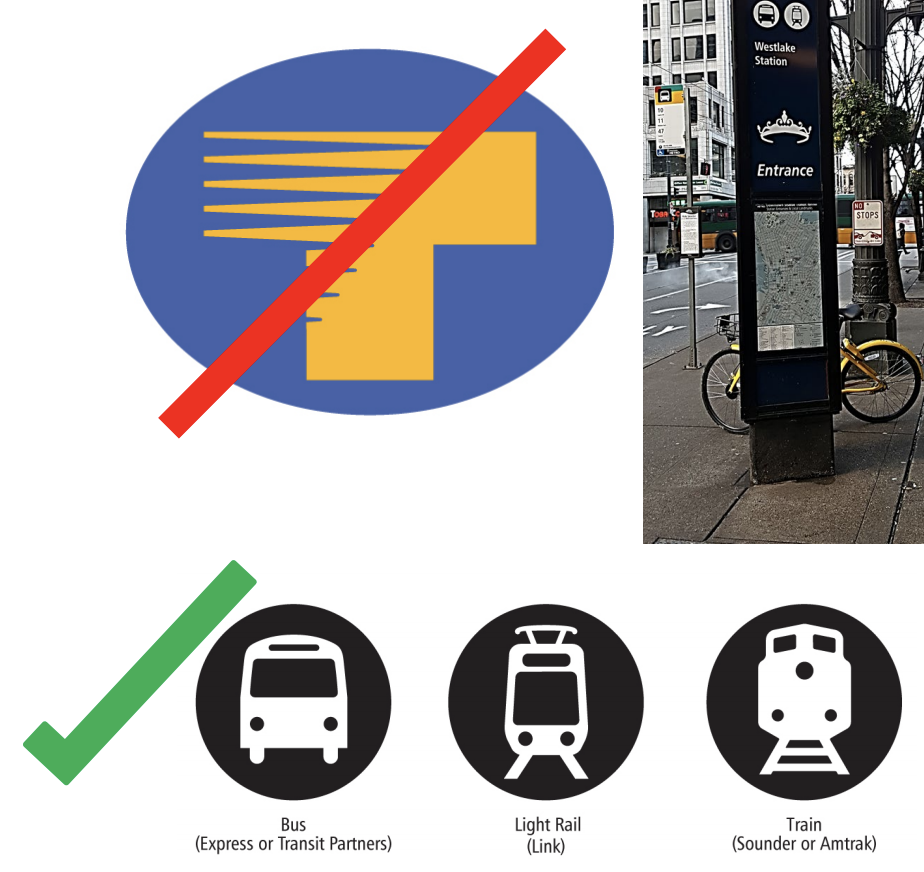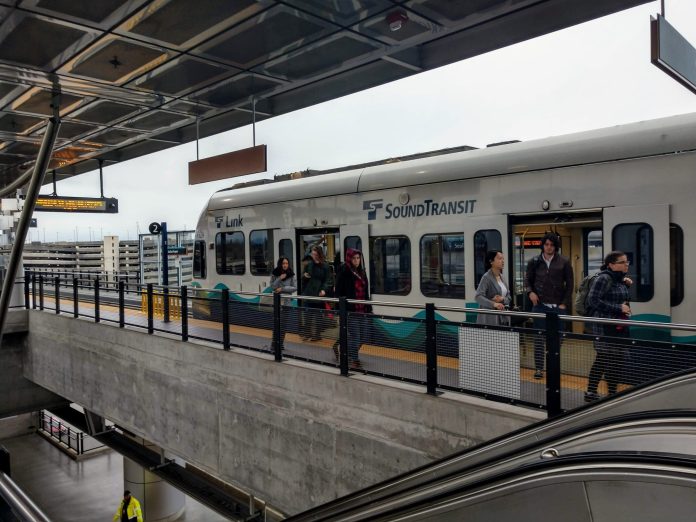New signage is coming to Sound Transit facilities. In a presentation last week to the System Expansion Committee, staff unveiled forthcoming wayfinding enhancement strategies, including a pilot program for four Downtown Seattle light rail stations to begin this month. A new station exit numbering system will replace existing station exit signs at the mezzanine and platform levels. These will be paired with visual directories that help with navigation. Staff also highlighted several other wayfinding enhancements that have recently been implemented or that are coming in 2021, 2024, and beyond.
Station exit signage pilot program
Starting this week, Sound Transit will begin installation of new station exit signage and companion visual directories to help riders navigate their way out of underground stations at Westlake, University Street, Pioneer Square, and Chinatown-International District. The visual directories will list station exit numbers, their direction, and be paired with nearby cross streets, landmarks, and points of interest. This will be paired with some images to provide additional visual context.

The numbered wayfinding approach is common in Asian metro systems, such as Seoul, Hong Kong, and Tokyo. Staff selected it because it is known to help non-native speakers, first time riders, illiterate individuals, and visitors navigate the system. The pilot program will be implemented by the Capital Signage Program and funded out of the operations budget.

Earlier this summer, Sound Transit staff were spotted briefly testing the wayfinding approach for a day in Downtown Seattle and surveying riders. This pilot program is expected to run through 2020. During that time, staff will continue to observe how riders respond to the new signage and conduct testing.
Location-relevant maps
Maps at stations currently indicate the line and merely mark to a rider that “you are here” at a given station location. Using an international best practice found in places like London, Vancouver, and Boston, Sound Transit plans to update static station maps at stations in 2021 to be location-relevant. This will coincide with the opening of the Northgate Link light rail extension when maps will need to be updated anyway.
The location-relevant map approach will be focused at and near platforms to help with riders’ confidence in their present location and direction of travel. Signage will be location-specific to show a diagram of the line, stations along it, and connecting line options at stations. Progress within the line will be shown by graying portions of the line that have already been traveled to the current station location, keeping color only for next stations on the line. The maps will also highlight the current station location.


Dynamic signage on trains
Beginning with the opening of the East Link light rail extension in 2023, Sound Transit plans to deploy the use of more dynamic signage. New light rail vehicles being purchased from Siemens will be outfitted with digital signage displays capable of showing train progress along a line. The signage will be able to highlight the current and next station stops, which is a common onboard feature in hundreds of metro and bus systems across the globe.

Another dynamic signage enhancement will be focused at platforms and other station digital signboards. Powered by the passenger information management system (PIMS), digital signs will be able to display the corresponding line color and letter of the next train to arrive. The digital signs will also be capable of providing estimated arrival times, destination, maximum passenger load, and number of train cars. Sound Transit has additionally said that PIMS-powered signs will allow special information and notifications to be displayed (e.g., service disruptions, emergencies, and other announcements).

As reported last year, Sound Transit initiated a $30.8 million contract with ARINC to deliver new systemwide digital signs and implementation of the PIMS. Full deployment of the system is anticipated in 2023 and would involve replacement of all digital signs at light rail and Sounder commuter rail stations. Existing Link stations, however, should have substantial installation of the digital signs completed by April 2022. The PIMS itself will involve deployment of an entirely new data platform, which would push information to digital signs and external public transit data feeds (e.g., Google Transit, Transit App, and OneBusAway). The new platform should ultimately result in even more accurate predictive arrival information.
Future totems

Sound Transit has surveyed hundreds of riders about the Regional T signage used across the system and on totems. Generally, riders did not find it particularly identifiable with only about a third of those surveyed recognizing it. However, more common images for trains and buses were found to be identifiable. In response, Sound Transit plans to retire the Regional T and has already done so at several locations, including Westlake Station and International/District Chinatown Station on totems.
Still, in other systems, a common metro sign like the Regional T can work if they are bold. Vancouver uses one for their system outside of stations, but it too pairs icons of transit modes with the signage and other wayfinding information.

What did appear to perform better among surveyed riders is concepts for tall totems that are highly illuminated, use large arrows and visual contrast, and show transit icons with mode. Sound Transit will progressively update and replace totems that meet this approach. Existing Downtown Seattle totems will likely feature a more modern, polished design than existing ones near entrances that emphasize the mode, use backlit lighting, icons of lines serving the stations, and sans serif typography. (An example is shown below on the left side.)

Recent wayfinding improvements
In the past several years, Sound Transit has made progress in improving its wayfinding. One example is when the Angle Lake Link extension was completed. The transit agency simplified its station signage for easier understanding. Platform signs trimmed down text and complexity of information so that riders could quickly scan them for the basic meaning. New wall signs were also installed to distill down key information for readability and usability.


At heavy-ridership stations, Sound Transit has tried to raise the profile of stations for better identification by passerby. Examples include the Pioneer Square light rail station where bold wrapping at the Third Avenue station entrance was added to make it obvious of where the underground station is located as well as the glass King Street Station entrance on S Jackson Street with supergraphics of the commuter rail icon and “Sounder” text are depicted.
Board authorization
A related board action to authorize a contract to implement signage enhancements as part of light rail expansions through 2024 was passed by the System Expansion Committee on Thursday unanimously. Motion No. M2019-109 authorizes approximately $13.8 million (including a 10% contingency buffer) to be spent on the procurement, fabrication, and installation of static signage at stations and onboard trains as well as the installation of between car safety barriers at station platforms.
Six system expansions are included in the contract, which encompass the Northgate Link (2021), Hilltop Tacoma Link (2022), East Link (2023), Lynnwood Link (2024), Federal Way Link (2024), and Downtown Redmond Link (2024) extensions. Costs will be apportioned proportionately by capital expansion program and charged to them rather than to other budget programs. Sound Transit has chosen Tube Art Displays, Inc. to be the primary contractor, but Windsor Fireform, Fraser Bronze Foundry, IRC, and Steven Graphics will also be paired as subcontractors for up to 13.8% of the contract total.
Stephen is a professional urban planner in Puget Sound with a passion for sustainable, livable, and diverse cities. He is especially interested in how policies, regulations, and programs can promote positive outcomes for communities. With stints in great cities like Bellingham and Cork, Stephen currently lives in Seattle. He primarily covers land use and transportation issues and has been with The Urbanist since 2014.



